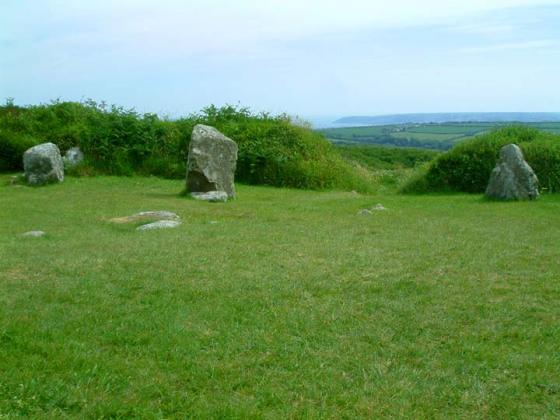
Trevelloe Carn from afar

Trevelloe Carn from afar
Visited 07.02.19
About 1 mile out of Sheffield on the B3315 towards St Buryan there is a crossroads. Trevelloe farm is on the left and Trevelloe House is on the right. Turn right down a farm track until you can see Trevelloe house on the right. There is a parallel private drive which is tarmacked. The Trevelloe Carn is visible within the grounds of Trevelloe House. It seems to have been incorporated into the garden. It does not seem that public access is encouraged so I settled for a distant view.
The grid reference may be fractionally out, but these rocks are definitely somewhere in the wood – hopefully next to the public footpath!
Trevella Carn, between two and three miles from Newlyn, is an object worthy of a walk. After passing through Newlyn on the Paul road, take the way to Buryan through the small hamlet of Sheffield, after passing which the first turning to the right leads direct to Trevella. The carn is situated a little to the right of the road.
Its summit is over nearly perpendicular rocks, at the bottom of which is a large cavity, formed by a large rock leaning against the main part of the pile, known by the country people as the Giant’s House. On the top of this carn are several rock-basons.
Mmm rock basins. From Rambles in Western Cornwall by the Footsteps of the Giants by J O Halliwell-Phillipps (1861).
Another little folklore snippet is that in William Bottrell’s long story in ‘Traditions and Hearthside Stories’ called ‘The Dwelling of Chenance’, he mentions that “people say, you know, that the devil’s huntsman and his hounds have often been seen (after hunting Trevella and Mimmis carns) to come down over the moor and vanish in the Clodgey pool. So maybe that might have been a local tale too. Mimmis Carn is eluding me, though H-P says it’s ‘a little distance from this carn, nearer St. Paul’. He says ‘upon it is a disposition of a rock in the form of a seat, called the Giant’s Chair. Near this was an ancient circle of upright stones, which was removed about twenty years ago.‘
The very lean-to stone mentioned in Halliwell-Phillipps’s book, taken by ‘Trepolpen’, plus other photos of the carn – the ones without people in shot belie the size of the stones.














































































































































































